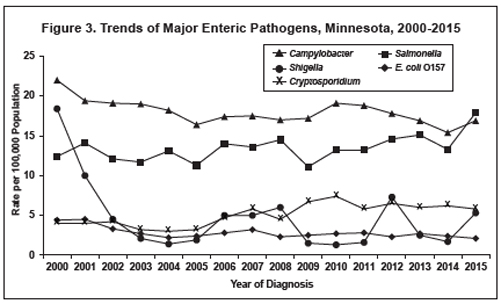Annual Summary of Disease Activity:
Disease Control Newsletter (DCN)
Related Topics
Contact Info
Campylobacteriosis, 2015
Campylobacter historically has been the most commonly reported bacterial enteric pathogen in Minnesota but was surpassed by Salmonella in 2015 (Figure 3). There were 924 culture-confirmed Campylobacter cases reported in 2015 (16.9 per 100,000 population). This is an 11% increase from the 834 cases reported in 2014, but similar to the annual median of 904 cases reported from 2005 to 2014 (range, 843 to 1,009). In 2015, 51% of cases occurred in people who resided in the metropolitan area. Of the 880 Campylobacter isolates confirmed and identified to species by MDH, 88% were C. jejuni and 8% were C. coli.
The median age of cases was 36 years (range, 2 months to 91 years). Fortythree percent were between 20 and 49 years of age, and 10% were ≤5 years of age. Fifty-nine percent were male. Fourteen percent were hospitalized; the median length of hospitalization was 3 days. Fifty percent of infections occurred during June through September. Of the 828 cases for whom data were available, 139 (18%) reported travel outside the United States during the week prior to illness onset. The most common travel destinations were Europe (n=38), Mexico (n=34), Asia (n=34), and Central or South America or the Caribbean (n=19).
Three foodborne outbreaks were identified in 2015. In April, an outbreak of C. jejuni and C. coli infections was associated with chicken liver pate served at a restaurant; 5 culture-confirmed cases were identified. In May, 3 culture-confirmed C. jejuni infections were associated with a wedding. In July, 3 culture-confirmed cases were associated with a family picnic. The vehicle of transmission was not confirmed for the latter two outbreaks.
A primary feature of public health importance among Campylobacter cases was the continued presence of Campylobacter isolates resistant to fluoroquinolone antibiotics (e.g., ciprofloxacin), which are commonly used to treat campylobacteriosis. In 2015, the overall proportion of quinolone resistance among Campylobacter isolates tested was 25%. However, 73% of Campylobacter isolates from patients with a history of foreign travel during the week prior to illness onset, regardless of destination, were resistant to fluoroquinolones. Fifteen percent of Campylobacter isolates from patients who acquired the infection domestically were resistant to fluoroquinolones.
In June 2009, a culture-independent test (CIDT) became commercially available for the qualitative detection of antigens in stool. In 2015, 675 patients were positive for Campylobacter by a CIDT conducted in a clinical laboratory. However, only 183 (27%) of the specimens were subsequently culture-confirmed and therefore met the surveillance case definition for inclusion in MDH case count totals.

- For up to date information see>> Campylobacteriosis (Campylobacter)
- Full issue>> Annual Summary of Communicable Diseases Reported to the Minnesota Department of Health, 2015